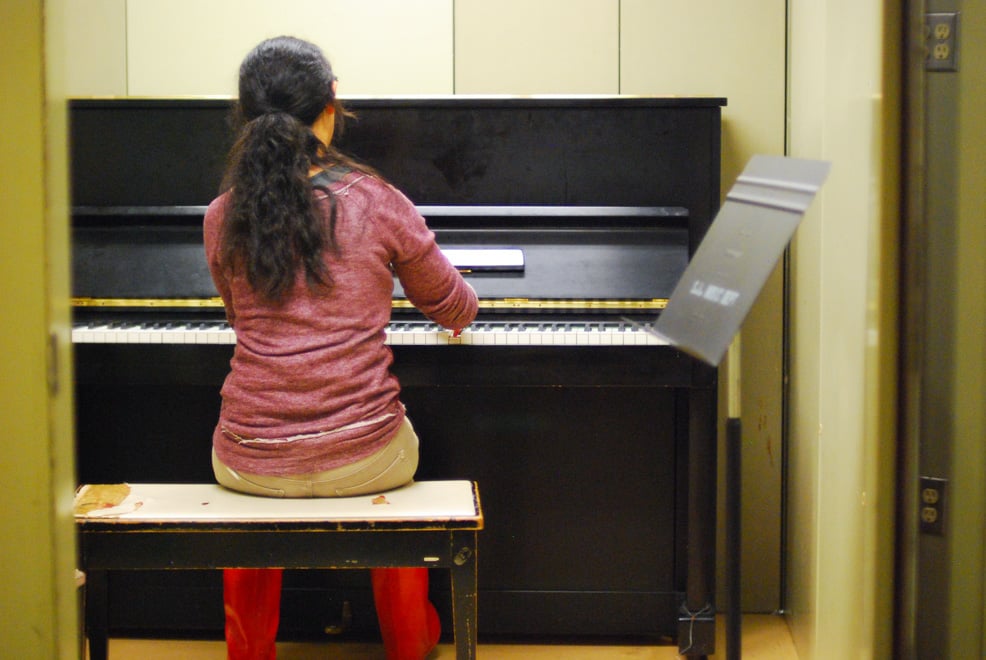Stepping into the Stanford arts scene, one cannot help but marvel at the magnificent scale of the Bing Concert Hall, the immense collections of the Cantor Arts Center, the life-changing performance of the Asian American Theater Project’s fall play Among the Dead or the Stanford Symphony Orchestra’s reverberating chords in Pines of Rome. The vast availability of performances and professional venues seem like everything students like I, an art enthusiast coming from a high school of limited scale, could hope for.
While I was dazzled by this abundance of opportunities, my desperate hunt for a room to practice flute before my Wind Symphony audition during the first week of school revealed to me the other side of the arts scene at Stanford: the struggle that students face to find a space to further their pursuits individually.
I first stumbled upon the music practice rooms in Braun Music Center. Google “music spaces Stanford” and you run across Braun 206, the only valid response on the page. Stepping into the glass doors and seeing the little cubicles where cellists struggled to avoid their arms hitting the piano or the wall, I was instantly transported back to boarding school where my love-hate relationship with practice cubicles in the basement of the arts building prompted me to rant in my Common App personal statement, “I hated how the dusty carpet sucked the glow out of my vibrato; I hated how the moldy walls killed the romance of practicing. But at the end of every school day, I was still stuck in ‘the dungeon.’”
After waiting 15 minutes for the next available cubicle, I caught myself staring at my sheet music blankly, distracted by the sounds around me. Another flautist in the room at the very end of the hall played running notes more flawlessly than I could ever dream of. The French hornist next door seemed to be also preparing for an ensemble audition, playing a section repeatedly. I played a hopeless middle register A, my sound dry and flat, with all the resonance absorbed by the enclosed, thick walls and lost in the cacophony. I stormed to my audition furious and underprepared.
This disparity between the Stanford arts scene and individual practice spaces hardly pertains to musicians alone; I have encountered similar grievances from visual artists or dancers. My dormmates and I, however, are the luckier ones. As members of the first-year Immersion in the Arts: Living in Culture (ITALIC) residential program, we have access to two conference rooms, a music room, collaboratorium and dance studio in the basement of Burbank House. The music room, home to a grand piano and drum set, became the favorite spot where we jam out or perfect our solos. I imagine that ITALIC alums return to live here year after year not only for the arts community but also for the practice spaces. Thinking through my living options next year, I, too, face the dilemma of whether to sacrifice my wishes to experience another themed house in order to maintain my access to the Burbank basement.
The condition of a working space is directly correlated to the productivity of an artist; this principle hardly needs a New York Times article to explain. More importantly, Stanford’s scarcity of attractive individual practice spaces discourages students from picking up a new instrument or medium. Scrambling to learn the drum set, my friend Sid Zhang ’25 complains of not being able to do so next year after her access to the Burbank basement expires. Until they become advanced enough to have their own studios on campus, my visual artist friends have their art-making opportunities limited to studio classes, which don’t always fit in their schedules.
As a university that prides itself on innovation, diversity and a welcoming environment, Stanford should expand students’ access to more attractive individual spaces where experienced artists, musicians, dancers and actors can hone their skills and beginners can improve through perseverance. Until then, Stanford lags behind in providing students with adequate support for their creative pursuits.
